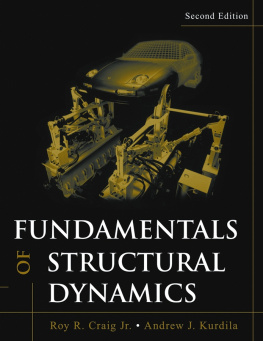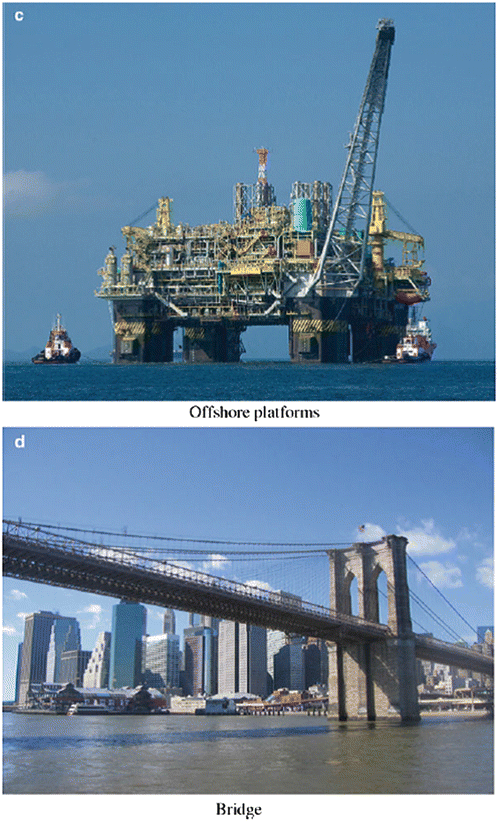Part I
Statically Determinate Structures
A structure is an assemblage of components which are connected in such a way that the structure can withstand the action of loads that are applied to it. These loads may be due to gravity, wind, ground shaking, impact, temperature, or other environmental sources. Structures are everywhere in the built environment. Buildings, bridges, tunnels, storage tanks, and transmission lines are examples of a structure. Structural engineering is the discipline which is concerned with identifying the loads that a structure may experience over its expected life, determining a suitable arrangement of structural members, selecting the material and dimensions of the members, defining the assembly process, and lastly monitoring the structure as it is being assembled and possibly also over its life.
In Part I, we first present an overview of structural engineering so that the reader can develop an appreciation for the broad range of tasks that structural engineers carry out and the challenges that they face in creating structures which perform satisfactorily under the loadings that they are subjected to. We then discuss a particular subgroup of structures called statically determinate structures. This subgroup is relatively easy to deal with analytically since only equilibrium concepts are involved. Also, most structures belong to this category. Trusses, beams, frames, cables, curved members, shallow foundations, and vertical retaining walls are described in separate chapters. The last two topics are not normally covered in elementary texts, but we have included them here for completeness.
In general, all structures can be classified as either statically determinate or statically indeterminate. Part II describes techniques for dealing with statically indeterminate structures.
Part III describes how the methodologies presented in Parts I and II are applied to engineer various types of bridges and buildings. This section is intended to identify the key issues involved in structural engineering practice.
Springer International Publishing Switzerland 2016
Jerome J. Connor and Susan Faraji Fundamentals of Structural Engineering 10.1007/978-3-319-24331-3_1
1. Introduction to Structural Engineering
Jerome J. Connor 1 and Susan Faraji 2
(1)
Department of Civil & Environmental Engineering, Massachusetts Institute of Technology, Cambridge, MA, USA
(2)
Department of Civil & Environmental Engineering, University of Massachusetts-Lowell, Lowell, MA, USA
Abstract
A structure is an assemblage of components which are connected in such a way that the structure can withstand the action of loads that are applied to it. These loads may be due to gravity, wind, ground shaking, impact, temperature, or other environmental sources. Examples of structures employed in civil infrastructure are buildings, bridges, dams, tunnels, storage tanks, and transmission line towers. Non-civil applications include aerospace structures such as airplane fuselages, missiles; naval structures such as ships, offshore platforms; and automotive structures such as cars and trucks. Structural engineering is the discipline which is concerned with identifying the loads that a structure may experience over its expected life, determining a suitable arrangement of structural members, selecting the material and dimensions of the members, defining the assembly process, and lastly monitoring the structure as it is being assembled and possibly also over its life.
In this chapter, we describe first the various types of structures. Each structure is categorized according to its particular function and the configuration of its components. We then discuss the critical issues that a structural engineer needs to address when designing or assessing the adequacy of a structure. The most important issue is preventing failure, especially a sudden catastrophic failure. We describe various failure modes: initial instability, material failure, and buckling of individual structural components. In order to carry out a structural design, one needs to specify the loading which is also a critical concern. Fortunately, the technical literature contains considerable information about loadings. We present here an overview of the nature of the different loads and establish their relative importance for the most common civil structures. Conventional structural design philosophy and the different approaches for implementing this design strategy are described next. Lastly, we briefly discuss some basic analytical methods of structural engineering and describe how they are applied to analyze structures.
1.1 Types of Structures and Structural Components
Structures are everywhere in the built environment. Buildings, bridges, tunnels, storage tanks, and transmission lines are examples of a structure. Structures differ in their makeup , i.e., the type and configuration of the components, and also in their function . Our approach to describing a structure is based on identifying a set of attributes which relate to these properties.
1.1.1 Structural Components
The components are the basic building blocks of a structure. We refer to them as structural elements. Elements are classified into two categories according to their geometry []:
Line Elements The geometry is essentially one-dimensional, i.e., one dimension is large with respect to the other two dimensions. Examples are cables, beams, columns, and arches. Another term for a line element is member.
Surface Elements One dimension is small in comparison to the other two dimensions. The elements are plate-like. Examples are flat plates, curved plates, and shells such as spherical, cylindrical, and hyperbolic paraboloids.
1.1.2 Types of Structures
A structure is classified according to its function and the type of elements used to make up the structure. Typical structures and their corresponding functions are listed in Table .
Table 1.1
Structures classified by function
Structural type | Function |
|---|
Building | Provide shelter above ground |
Bridge | Provide means of traversing above ground over a site |
Tunnel | Provide means of traversing underground through a site |
Tower | Support transmission lines and broadcasting devices |
Retaining walls | Retain earth or other material |
Containments | Provide means of storage of materials, also enclose dangerous devices such as nuclear reactors |
Platforms | Provide a platform for storage of materials and machinery either onshore or offshore |
Fig. 1.1
Examples of typical structures classified by function
Table 1.2
Structures classified by makeup
Structural type | Composition |
|---|
Frame | Composed of members rigidly or semirigidly connected in rectangular or triangular patterns |















